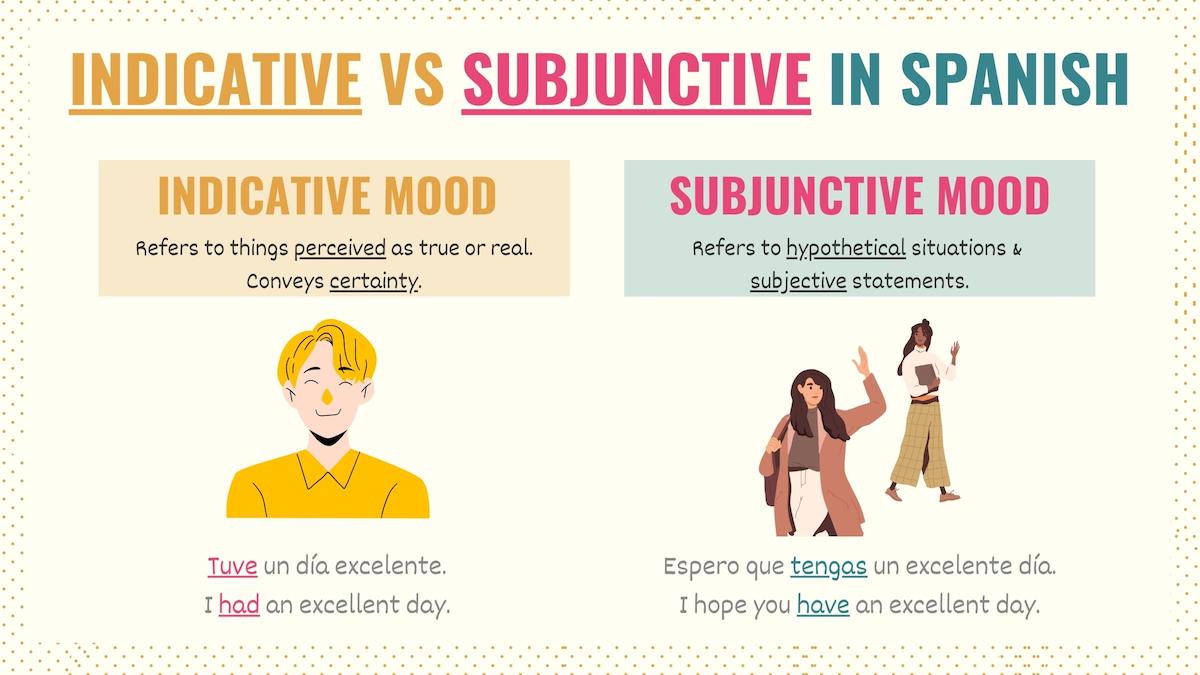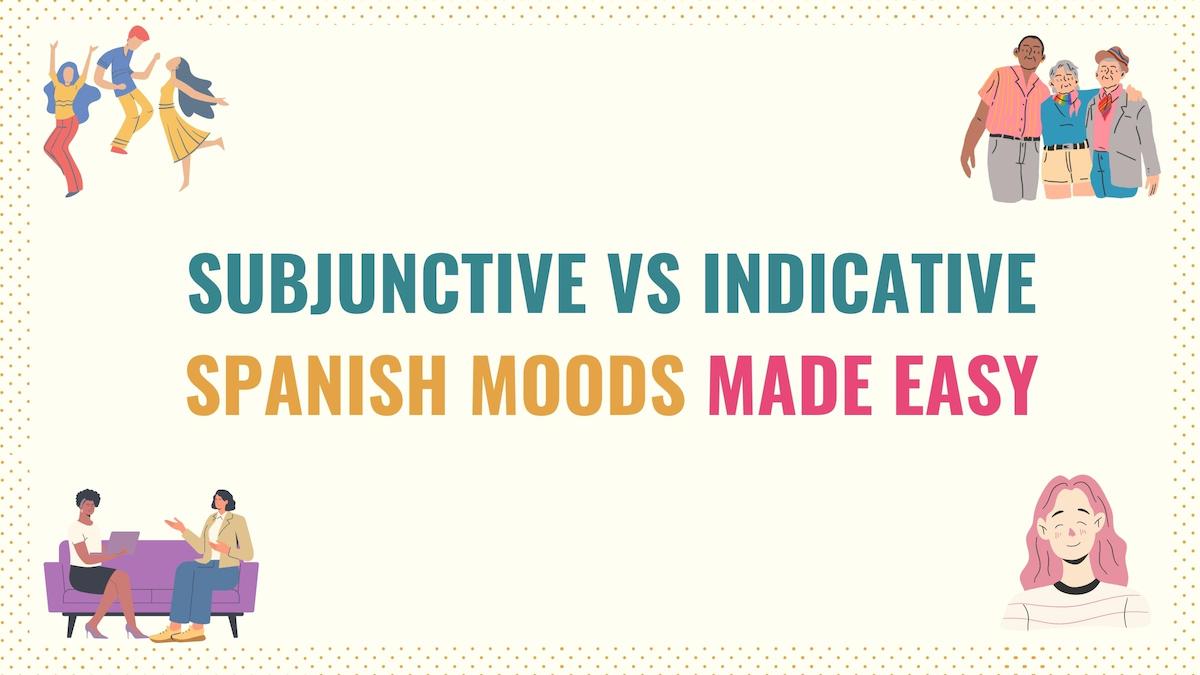The indicative and subjunctive moods are an essential part of Spanish grammar. Understanding them is crucial because they allow you to talk about actions from different perspectives. So, in this subjunctive vs indicative Spanish moods guide, you’ll discover everything you need to know about them.
- When to Use Indicative or Subjunctive
- Indicative & Subjunctive Conjugation Charts
- Bonus: When to Use Indicative, Subjunctive, or Infinitive
- Key Points
- What to Do Next
Difference Between Indicative and Subjunctive in Spanish
Moods convey the speaker’s perception or attitude toward an action. In simple words, they express how people feel or think about the information they deliver. The subjunctive and indicative are two of the three verb moods in Spanish.
The main difference between the indicative and subjunctive is the type of perception or attitude they convey.
Let me break this down for you.
The indicative mood in Spanish is used when the speaker presents information as a fact. Simply put, the indicative expresses certainty and talks about things believed to be true. So, in short, this mood relates to reality.
On the contrary, the Spanish subjunctive communicates uncertainty, wishes, possibilities, emotions, suggestions, and demands. In summary, the subjunctive relates to hypothetical situations and subjectivity.
Here are some examples using the same verbs (ser, ir, and tener) in indicative and subjunctive forms:
| Indicative | Subjunctive |
|---|---|
| Tuve un día excelente. I had an excellent day. | Espero que tengas un excelente día. I hope you have an excellent day. |
| Ella es la hermana de Diego. That is Diego’s sister. | ¿Crees que ella sea la hermana de Diego? Do you think that is Diego’s sister? |
| Mañana vamos al dentista. Tomorrow, we will go to the dentist. | Quiero que vayamos al dentista mañana. I want us to go to the dentist tomorrow. |
If you pay close attention, you’ll realize that each mood’s message is different. Take pair #3 as an example.
The sentence in indicative form indicates with certainty my plans for tomorrow. This is a concrete plan that will happen in the future. On the flip side, its subjunctive counterpart states my wishes.
And this is key.
Because no matter how much I want us to go to the dentist, it doesn’t mean this action will necessarily happen. You may not want to go, or he may not be available. This is just a hope, which means the actual action is still unreal.

Subjunctive vs Indicative Spanish Endings
When it comes to the indicative vs subjunctive Spanish moods, they also have different tenses and distinctive conjugations. These tenses allow us to convey the time when the action happens or when the speaker has a wish, doubt, etc.
Here is a breakdown of the Spanish tenses for these moods.
Indicative tenses
- Present
- Past preterite
- Past imperfect
- Future simple
- Conditional
In addition to the simple tenses, the indicative also has progressive and compound forms, such as the pluperfect and the present progressive.
Subjunctive tenses
- Present subjunctive
- Present perfect subjunctive
- Imperfect subjunctive
- Past perfect subjunctive
As established before, the conjugation endings you use for the indicative are different from those we need to form the Spanish subjunctive.
Here is a conjugation chart with the endings for -AR verbs comparing the present and past tenses for the subjunctive and indicative.
| Person | Present Indicative | Present Subjunctive | Preterite Indicative | Past Subjunctive |
|---|---|---|---|---|
| Yo | Hablo | Hable | Hablé | Hablara |
| Tú | Hablas | Hables | Hablaste | Hablaras |
| Él / Ella Usted | Habla | Hable | Habló | Hablara |
| Nosotros | Hablamos | Hablemos | Hablamos | Habláramos |
| Vosotros | Habláis | Habléis | Hablasteis | Hablarais |
| Ellos / Ellas Ustedes | Hablan | Hablen | Hablaron | Hablaran |
The subjunctive conjugations are easier than you think since they’re heavily based on their indicative equivalent. In other words, to form the Spanish present subjunctive, you’ll rely on the present indicative, and the past subjunctive conjugation is based on the preterite forms.
Take Note: Don’t confuse moods with Spanish tenses. A tense refers to the time when something happens, whereas moods express how the speaker perceives the information. As a result, a mood can be conjugated in different tenses.
Bonus: Indicative vs Subjunctive vs Infinitive Verbs in Spanish
Now that you understand how these verb moods work, you should also check when to use Spanish infinitives instead of a verb in the subjunctive mood.
In Spanish, most subjunctive sentences have two subjects and two verbs. For example:
Yo quiero que tú hables con ella.
I want you to speak with her.
These types of sentences allow you to express what the speaker wants, doubts, recommends, or demands from another person. However, you must use an infinitive verb if that hope, uncertainty, or suggestions circles back to the same subject:
Yo quiero hablar con ella.
I want to speak with her.
Spanish infinitive verbs can also be used after a conjugated indicative verb:
Vine a ver cómo estás.
I came to see how you’re doing.
Key Points
The subjunctive and the indicative are essential Spanish moods. Knowing how and when to use them can help you express your ideas more clearly. Here are some important key points to keep in mind.
- Spanish moods convey how the speaker feels or sees the information.
- The indicative mood in Spanish refers to information perceived as real. As a result, it conveys certainty.
- Use the Spanish indicative to describe your habits, memories, plans, and people.
- The Spanish subjunctive mood is used to express demands, advice, wishes, emotions, and doubts about the action someone else does.
- Spanish moods can be conjugated in different tenses to explain when an action took place.
- The main indicative tenses are present, preterite, imperfect, future, and conditional.
- On the other hand, the subjunctive tenses are present, present perfect, imperfect, and past perfect.
- The difference between the indicative and the subjunctive in Spanish is whether the speaker refers to real actions or not.
Subjunctive vs Indicative Additional Spanish Resources
The Spanish imperative is the third mood and we use it to give commands. You need to understand how it works and how to form it to understand verb moods fully. Also, take the time to study the subjunctive and indicative moods and their different tenses.
Knowing some common Spanish subjunctive triggers is a simple way to train yourself to identify situations requiring subjunctive. Once you’re ready, you should take a subjunctive vs indicative quiz to test your knowledge.
Download the Subjunctive vs Indicative Moods PDF
Congratulations! You’ve now learned about one of the most difficult grammar topics with which people learning Spanish struggle. Feel free to download a copy of the PDF for this subjunctive vs indicative Spanish moods guide to study all the graphics, key points and differences whenever you need a refresher on it.



